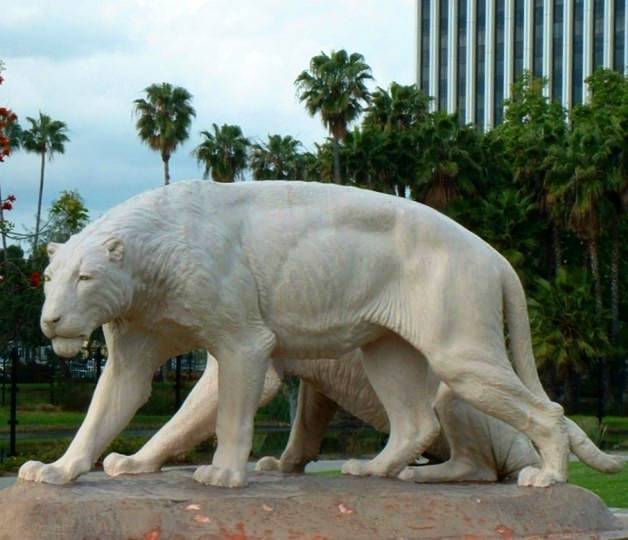American Lion (Panthera leo atrox) - Wiki American Lion
From Wikipedia, the free encyclopedia
[Photo] A statue of North American Lion at Rancho La Brea Tar Pits. http://www.homeofourfathers.com/lisbeth/journal1apr2006.htm
The American lion, also known as the North American or American cave lion, is an extinct feline known from fossils. It is comparable in size to the Eurasian cave lion, considered to be the second largest species of lion to have ever existed (after the cave lion), and was about 25% larger than the modern African lion.
Description
The American lion averaged 3.5 m (11.5 ft) in length, with a typical male weighing about 235 kg (520 lb), and a typical female weighing about 175 kg (385 lb). It was comparable in size to its close relative the Eurasian cave lion, the modern Amur tiger and the hybrid liger, which is a hybrid that probably never occurs without human interference . They were still smaller than their contemporary, the short-faced bear, which is the largest carnivore of their era.
About a hundred specimens have been recovered from the La Brea Tar Pits, in Los Angeles, so their body structure is well known. The features and teeth of the American lion strongly resemble modern lions, though they were considerably larger, and their limbs were longer and more gracile by comparison. As a result, it is likely that they could sprint even faster than African lions. They probably were plain coloured, and males would have lacked a mane, like their close relative the Eurasian cave lion
They had the largest brain compared to their body size of any lion, living or dead (see also: encephalization quotient), so they were probably smart enough to engage in complex social behaviors. There are also fewer American lions in the La Brea tar pits than other predators, which suggests they may have been smart enough to avoid the hazard or their hunting methods and strategies didn't include hunting entrapped prey.
Environment
Radiometric dating of remains indicates the American lion lived 25,000 to 10,000 years ago, during the Pleistocene epoch. They were one of the abundant Pleistocene megafauna - a wide variety of very large mammals that lived during the Pleistocene. They were probably cave lions from Eurasia who crossed the Bering land bridge into Alaska, and became isolated about 35,000 years ago during the last ice age. They ranged across Alaska and the Yukon in the north, and during the Wisconsin glaciation they were pushed south as far as Peru, just before their extinction. While the American lion did reach Florida, there have been no remains recovered from eastern Canada and the northeast United States; the large, dense forests may have been impassable. Remains are most common in the Yukon, and from the La Brea Tar Pits.
They probably used caves or fissures for shelter from the cold weather. They may have even lined their dens with grass or leaves, like the Siberian tiger, another great cat that lives in the north.
They were more common than the other large predators of their era, like the short-faced bear and the scimitar cat (a type of saber-toothed cat), so they were probably quite successful. They likely preyed on deer, North American horses (now extinct), American Bison, young mammoths, and other large, herbivorous animals. Male and female specimens are evenly distributed in the La Brea Tar Pits, which indicates they hunted alone or in pairs, since modern lions, who are gregarious hunters, have an unequal distribution.
Their extinction may have been related to the Holocene extinction event, which wiped out most of their megafauna prey. Their bones have been found among the refuse of Paleolithic Native Americans, so hunting by humans may have also contributed to their demise.
A replica of the jaw of the first specimen of American lion ever discovered can be seen in the hand of a statue of paleontologist Joseph Leidy, which is currently standing outside the Academy of Natural Sciences in Philadelphia.
Classification
The American lion is normally considered a subspecies of lion, with the scientific name of Panthera leo atrox (IPA pronunciation: [pænθ??r?? ??le??.o ??tr??ks]), which means "cruel" or "fearsome lion" in Latin); but it is occasionally considered a species in its own right, under the name Panthera atrox. At least one authority, based on a comparison of skull shapes, considers the cave lion to be more closely related to the tiger, which would indicate the proper name for the American lion is Panthera tigris atrox (Groiss, 1996). However, recent genetic work shows that it was a close but separate relative of the modern lion.
History
The earliest lion was the European "jaguar" Panthera gombaszoegensis, which lived about 1.5 million years ago; remains have been found in both Italy and Germany. More immediate ancestors are the Panthera leo fossilis from the Olduvai Gorge in East Africa, a primitive lion with tiger characteristics, that first appeared about 500,000 years ago; and the Panthera youngi from Choukoutien, China, which lived about 350,000 years ago, and is apparently an ancestor of both the American lion and the Eurasian cave lion.
http://en.wikipedia.org/wiki/American_lion
| The text in this page is based on the copyrighted Wikipedia article shown in above URL. It is used under the GNU Free Documentation License. You may redistribute it, verbatim or modified, providing that you comply with the terms of the GFDL. |
